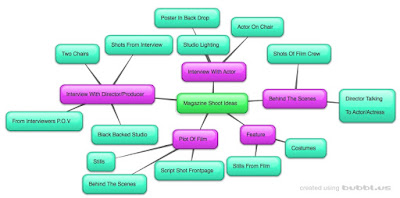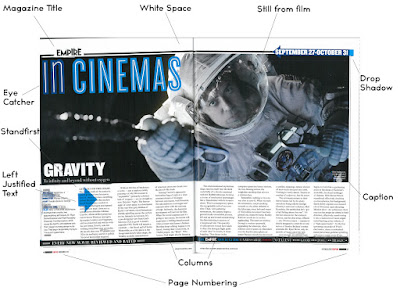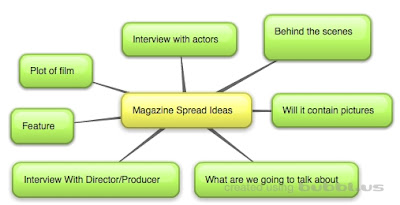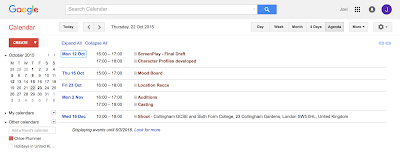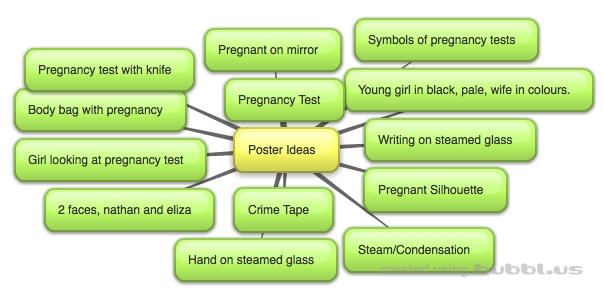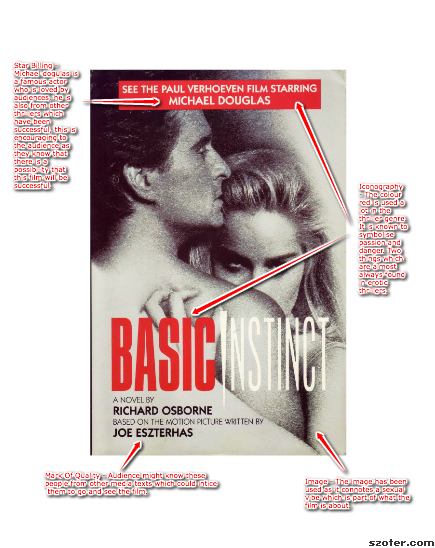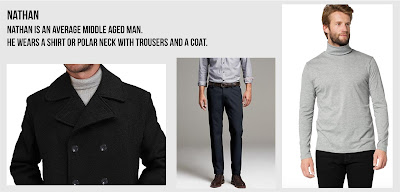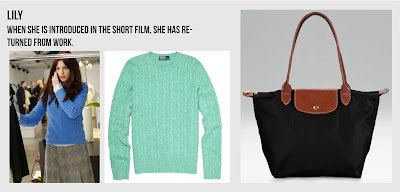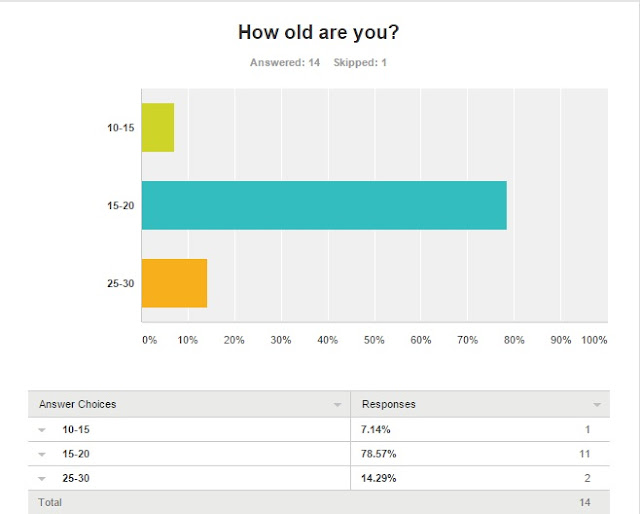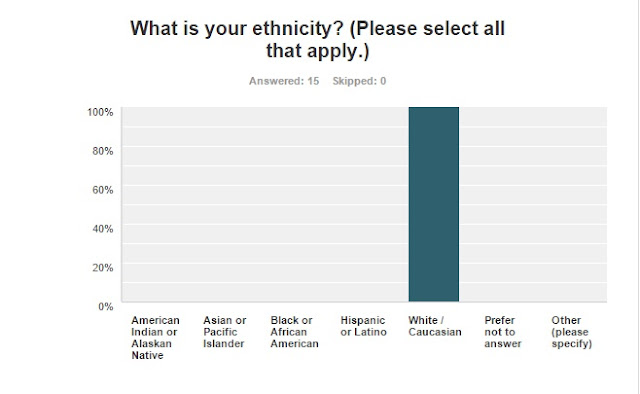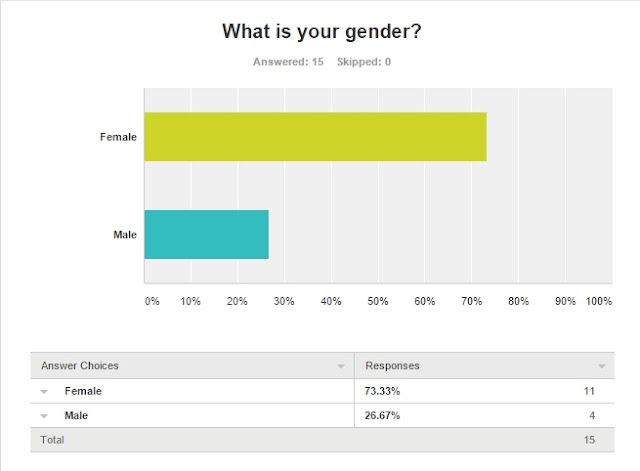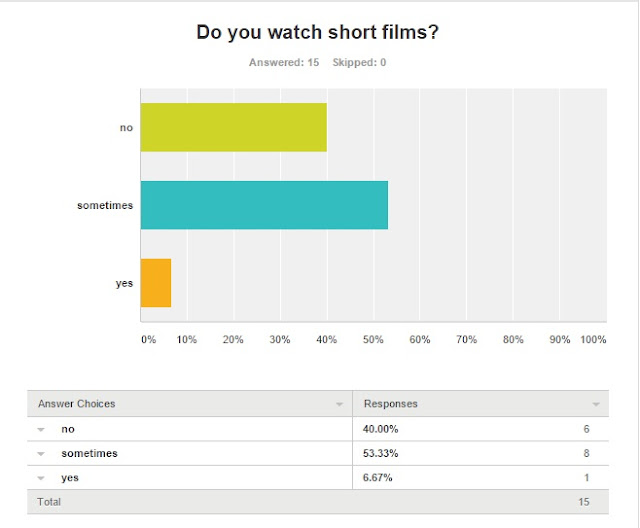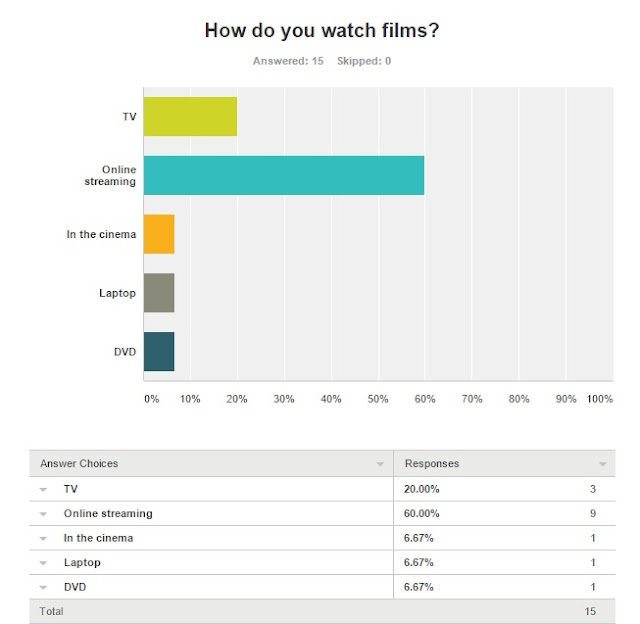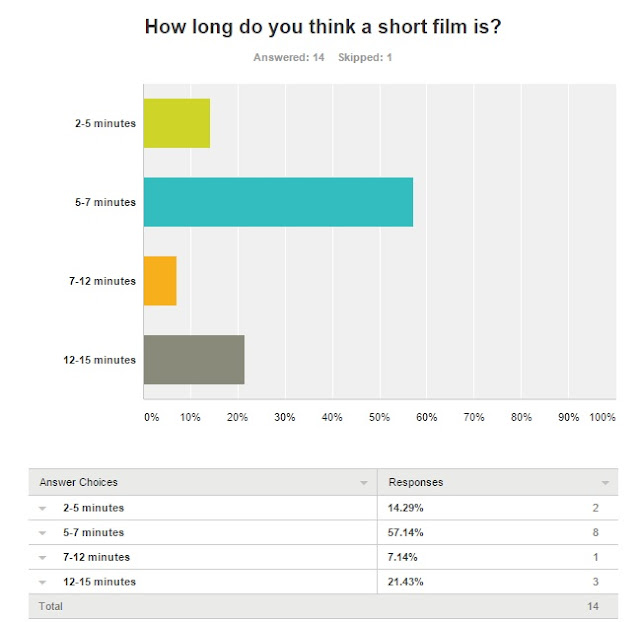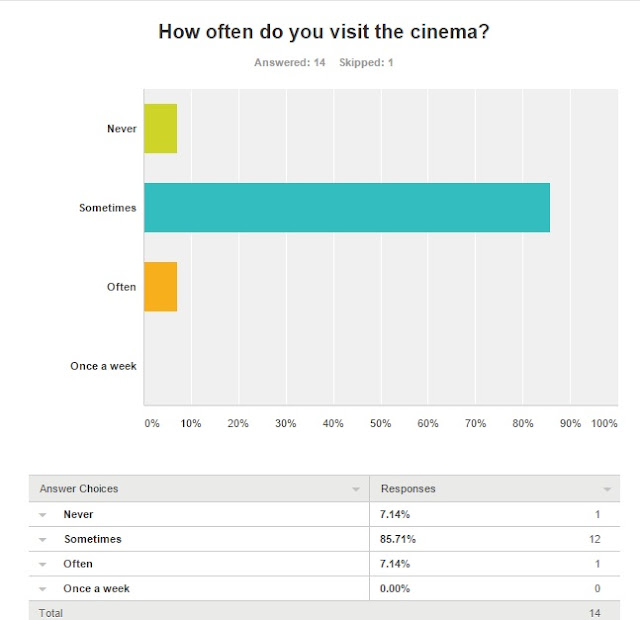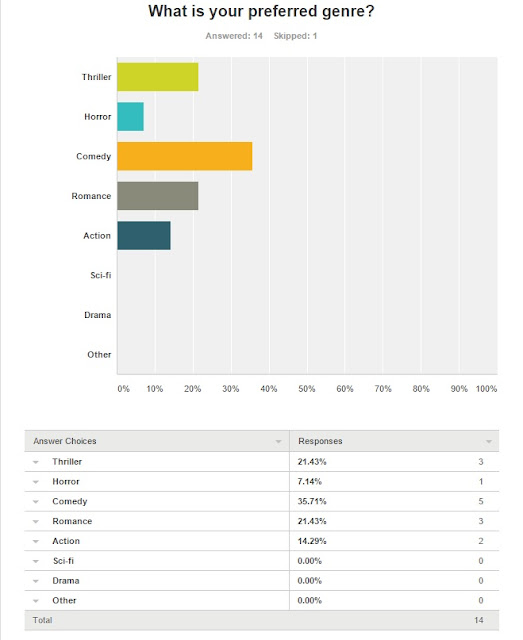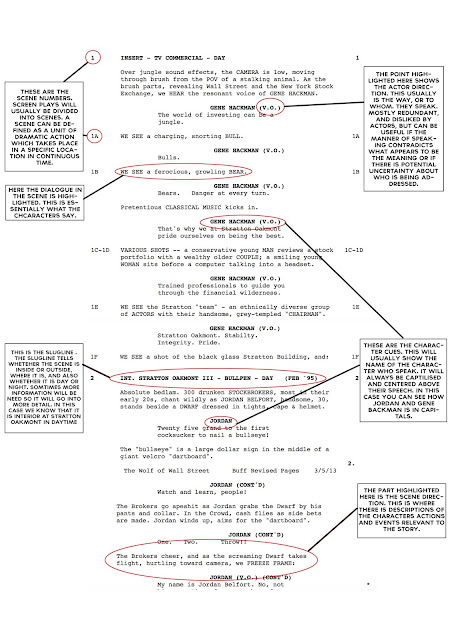collingham

Monday 30 November 2015
Thursday 26 November 2015
Questions For Our Focus Group
Did you like the style of the film?
Did you like the pace of the film?
Did you feel scared?
Was the music right for the film?
Would you recommend this short film?
Would this make you want to watch more short films?
Did you like the story line?
What did you think of the camera work?
What did you think of the credits?
Did you feel hooked throughout?
Did you think the twist was exciting enough?
Monday 23 November 2015
Thursday 19 November 2015
Wednesday 18 November 2015
Audience Profile
For our media production we established an audience profile. We profiled our into the audience demographic of ABC1s. These are upper to lower middle class individuals. In terms of psychographics we looked at how our audience could be profiled by means of social class, lifestyle and personality characteristics. It is based on the assumption that the types of products and brands an individual purchases will reflect that persons characteristics and patterns of living. The main one we picked out for our audience is the explorer due to the fact that our film is a niche topic, which is often not touched upon, therefore leading us to believe that they might seek to consume our media product in terms of discovering and learning about the issues within our product.
The profiles above were created by the advertising agency Young And Rubican.
Monday 16 November 2015
Magazine Spread Conventions
To create these i annotations i used a software called Photoshop which made it easy for me to customise and move elements.
Questionnaire Evaluation
Advantages
- The advantages of our questionnaire are that we now have a clear idea of who our target audience and target demographic are.
- We established the age, race and gender of our target audience.
Disadvantages
- We didn't find out what our target audience want to see in a short film.
- We should have had a larger age range as there was no option for people over thirty years old which limited our results.
- We found out that our target audience don't watch short films that often.
Misconception Credit Ideas
In this post i am going to be evaluating different film title sequences to come up with some ideas for the title sequence in our film.
Ginger Snaps (2000)
Ginger Snaps (2000)
In this title sequence i like how they have used a mixture of stills and video. I particularly like how they move the camera across the still. This provides an interesting effect to the image. Another good point about this is the way the text is usually in one corner of the image, it doesn't draw the viewers attention away from the still.
Se7en (1995)
In this title i firstly like how the shots have a grungy feel to them. There are also lost of quick cuts which brings more tension into it. The way they have made the font shake also adds a lot of tension to the title sequence.
In summary i think that the main things we should focus on for our title sequence are:
- Lots of quick cuts
- Grungy Filter
- Desaturated Colours
- Camera Movement
- Use of Stills And Film
Film Title Font Colour Ideas
To create this graphic i used a software called Photoshop because i wanted to create an interesting way to display our investigations into the different colours available to us.
Thursday 12 November 2015
Misconception Title Fonts
To create this graphic i used a software called Photoshop because i wanted to create an interesting way to display our investigations into the different fonts available to us.
Monday 9 November 2015
Thursday 5 November 2015
Monday 2 November 2015
Short Film Analysis 2
The Most Beautiful Man In The World
‘The Most Beautiful Man In The World’ is a BAFTA nominated short film directed and written by Alicia Duffy in 2002. The film’s focus is the theme of youth, in particular the complexity of children’s needs, feelings and experiences, while the story itself centres on the neglect of a young girl, and her need to be free and stimulated. This need is then fulfilled when she escapes her house and is at one with nature, where she encounters a man whose identity as the girl’s father is unknown.
The film invites a variety of interpretations according to the different ideologies of audience members and the complex issues raised. The issue of neglect is prominent throughout the short, with the TV being shown as the only source of stimulation in the girl’s life and the absence of her mother and lack of care received noticeable. A number of different views and ideologies surround this issue with one of the main, dominant views being that a mother should be caring for her young child instead of leaving them to technology. The issue of neglect and child welfare is exposed throughout the opening scene where the TV is seen as the central force in the girl’s life and the one and only form of contact and interaction she has. This symbolisation of the TV highlights the girl’s lack of communication and care and raises the binary opposition of nature vs. nurture.
The variety of different camera shots used and the drab mise-en-scene of the scene also adds to the girl’s lack of stimulation while informing us of the family’s financial hardship. The use of camera and mise-en-scene come together in the use of a wide shot of the girl lying on the floor of an old-fashioned, run-down living room, where she is alone apart from her dog and the sound of her mother’s voice. This shot presents a representation of the girl as being isolated, lonely, fragile and trapped in her home with the bright light from the world outside streaming into the drab room from behind the dirty net curtains. This contrast in lighting showcases the juxtaposition between the entrapment the girl feels inside her home and the freedom she feels when left to roam outside. The theme of entrapment vs. freedom is also shown through the strong use of close-ups and extreme close-ups in the interior scenes compared to the wide shots used when the young girl is out in the field.
In addition to this, the technical element of sound is also used to portray the issue of neglect, as at the beginning of the film the diegetic sound of a television can be heard displaying violent sounds such as guns and arguing, while the camera is focused on the young girl with the light from the television illuminating her face. The sound from the television sounds like a cartoon although it could easily be a violent film or television programme. These diegetic sounds leave the audience wondering why this young girl is possibly watching this and raises the concern that there should be someone there to stop her from doing so. She is also wearing dirty clothing, again raising the idea that she is not being looked after correctly.
Furthermore, the issue of neglect and child welfare is also presented through the use of the girl’s mother being absent yet present throughout the film; this is achieved by never showing the mother however hearing her voice while she is on the phone and discussing money with a companion. While she is on the phone we can tell that this character is young due to the soft, depressed tone of her voice and her monosyllabic, short sentences making her sound weak, vulnerable and stressed. This theme of money and financial strain, along with the idea of a young, single mother, achieves a sense of realism within the film while helping to develop this character and make audience members sympathetic towards her. One ideology that audience members may have to this woman’s financial problems is the socialist ideology that as a young, single parent she should be supported by the state. At this point it is also worth noticing how no government ran authorities are being represented within the text. For example, if the child was seriously being neglected would social services not be attempting to help them and the family in anyway? The reason why social services may not be represented is due to the fact that in today’s society local councils have received a great deal of criticism in failing to spot child neglect cases, sometimes even resulting in the death of the child.
The fact that the mother is the only parent seen and heard in the house could go some way to explain why the child is suffering from some form of neglect and could also help us to understand why the family are suffering economically. This then raises the question as to where the girl’s father is and brings up the ideology that the father, whether in a relationship with the mother or not should be there to support his child and her mother both emotionally and financially. However although the girl’s mother isn’t particularly present and her father is obviously absent from her life she does have some sort of guardian, with the dog constantly looking over her and being by her side, both inside and outside the house.
Once the girl steps outside her prison-like home her disposition changes, relishing in her new found freedom, walking with her arms spread open and invigorating her senses by brushing along the plants. This scene relies heavily on the use of diegetic sound with the sound of insects, water and plants rustling in the wind being extremely exaggerated and combining together to stimulate the girl. This combination of sounds contrasts with the sound in the interior scenes where the only sound is coming from the television; this shows how much more of a stimulating environment it is for the girl. The editing also helps to add to the excitement of the scene by using jump cuts to give a sense of the exhilaration the girl is experiencing.
Shortly after the girl begins to explore, the dog runs off and she goes to find him. It’s at this point in the film where the girl finds the man stroking her dog, with the audience not knowing who he is or where he has come from. This allows the audience to interpret who he is in and what he’s about to do in whichever way they feel necessary, with the main assumption being that he is about to harm the girl in some way. This was Alicia Duffy’s rationale when making the film to help keep the plot and the characters ambiguous, also achieved by the lack of dialogue within the text. However, if we delve deeper into the language of the film we begin to realise that this man isn’t a threat to the girl. First of all the man is stroking the dog and the dog isn’t retaliating or being protective towards the child, this suggests that the dog knows the man and knows he is of no harm to the girl. The man also gently picks a bug off the child showing an intimacy between the two, this intimacy shown through the extreme-close up of his hand picking the bug from the girl’s shoulder. The man then smiles at the child and she smiles back, this smile hints towards the suggestion that there may be a relationship between the two characters as it is the first kind of human connection we see the girl have. The young mum is then seen standing at the door of the house watching over her child, she appears calm and composed indicating that she knows the man and that he is of no harm to her daughter. This again backs up the idea that he is the girl’s father.
Once the girl is back inside her house she is once again trapped watching the TV with no stimulation or contact from anyone. The editorial pace also slows down with the shots lasting longer and the lighting becoming once again darker.
Throughout the film the main representational focus is on age; this can be looked at from two perspectives with both the young girl’s boredom and need for stimulation and the young, single mothers struggling, both emotionally and financially, being represented. The girl’s mother’s age is being represented through the narrative storyline of the mother being a young, single parent who is struggling with money worries and who is also finding it difficult to care for her child and give her what she needs; this is a fairly stereotypical representation of the mother as society often criticises and has strong views about young, single mothers not being able to care for their children correctly. Class and status also plays a role in the representation of the mother as we can tell from the run-down mise-en-scene of the house and narrative of the story that she is from a lower class family.
One of the key themes throughout the film is that of Freedom vs. Imprisonment; this theme relates not only to the child and how she is trapped inside her house but also relates to the mother being trapped with the child while the father is free and allowed to do what he wants. This is a representation of gender as women are usually the ones to care for children when partners split while men are able to live their own lives; this is shown again through the close-up shots and dark, depressing lighting used in the interior scenes compared to the wide shots and bright, airy lighting used in the exterior scenes where both the mother and father feature respectively. The costume of who we believe to be the girl’s father also represents his freedom as we see him shirtless, the connotations of this being that the man is free and liberated.
Overall this short brings many ideologies to the foreground and raises many questions about the splitting of parents and how this affects children.
Monday 26 October 2015
Thursday 22 October 2015
Tuesday 20 October 2015
Target Audience Profile
The Target Audience for our Short film, Misconception are between the ages of 15-20 and the majority are female. Most do not watch short films but watch a lot of feature length films, including going to the cinema. Their preferred method of viewing is online streaming. The Thriller genre was popular among those who are our Target Audience.
Our audience demographic our those in categories ABC1 because Short Films are commonly considered as high cultured and elite. Those in ABC1 have a professional occupation.
The target Psychographics of our short film could be, The Explorer because not many people choose to watch short films but the explorer are often trying out new ideas and experiences. Our target psychographic could also be, The Aspirer and/or, The Succeeder.
The Aspirer - Materialistic, acquisitive people, who are driven by others' perceptions of them rather than by their own values. as a result, they respond to what others perceive as being superficial: image, appearance, persona, charisma and fashion. an attractive pack is as important to them as its contents. Their core in life is for status.
Demographics
Our audience demographic our those in categories ABC1 because Short Films are commonly considered as high cultured and elite. Those in ABC1 have a professional occupation.
Psychographics
The target Psychographics of our short film could be, The Explorer because not many people choose to watch short films but the explorer are often trying out new ideas and experiences. Our target psychographic could also be, The Aspirer and/or, The Succeeder.
The Aspirer - Materialistic, acquisitive people, who are driven by others' perceptions of them rather than by their own values. as a result, they respond to what others perceive as being superficial: image, appearance, persona, charisma and fashion. an attractive pack is as important to them as its contents. Their core in life is for status.
The Succeeder - They possess self-confidence, have a strong goal orientation and tend to be very organised. as a result, they tend to occupy positions of responsibility in society. their investment in the status quo means they tend to support it. when it comes to brands, they seek reward and prestige, and will often seek out the best, because that is what they feel they deserve. on the other hand, they also seek out caring and protective brands - their aggressive attitude to life means they need to relax occasionally. Their core in life is for control.
Thursday 8 October 2015
Monday 5 October 2015
Thursday 1 October 2015
Short Film Analysis 1
In this post i am going to be doing an in-depth analysis of a short film. The one i have chosen for this is called Lovefield which was directed by Mathieu Ratthe.
Lovefield:
Micro Elements:
Camera Angle, Movement and Position:
- Establishing shot - iconic image of the wheat field
- Camera pans lowers down to each strand of wheat, the focus blurs as it zooms in on each strand of wheat. Variation in depths of field.
- Wide shots to show how far away from civilisation the film is set. No one could hear or help you.
- Slow movements - There is a slow camera rise showing a crow sitting on a welcome sign. This has been used to create tension.
- Slow diagonal pan showing phone and money as well as other objects. This could be used to give audiences clues.
- The camera pans up to reveal a man.
- Focus is racked between him and the crow showing that the man knows the crow is the only witness.
The manipulation of the camera only tells one part of the story, filling us with a sense of dread until all is revealed.
Framing:
- The man is usually in the middle of the shot this means that the focus is on him and his reactions.
- Rule of thirds - When he stands up and looks around (for the police car), He’s in the middle of the screen to show how isolated he is. It shows that there is no help around.
- The director has chosen not to put the woman in the frame, otherwise the plot of the short film wouldn’t be too interesting.
- The wheat field location has been put in a wide frame, this shows how isolated the characters are.
Editing:
- Fade transitions is used to create tension from the image of the wheat.
- Editing and Sound working together to add to the tension of the scene when the foot goes still and the knife strikes the ground.
Mise En Scene:
- The crow is a connotation of bad luck. Mathieu Ratthe has also used this connotation in other short films as such as ‘The Talisman’.
- Number 13 - On the ‘Welcome to Hedren Hill’ sign, it says there are 13 miles to Bishopsville, the number 13 is known as bad luck. This is another connotation of bad luck.
- Location - The location is a wheat field. It is quite an iconic image and also is intertextual with the film Gladiator.
- Props:
- There is a phone which shows the audience that someone has tried to make a hasty phone call.
- We can see money on the ground, is the person being robbed, brings a question to the audience.
- Undergarments - These are covered in blood. This leads the audience to assume that if she isn’t being robbed for money, she’s being raped.
- Bin bag - When we see the bin bag the man pulls out from the car boot, we get the idea that it’s so he can hide/cover the body.
- Costume - Man wearing dungaree’s and baseball cap, creates a suspicious look for him.
- Lighting:
- In the beginning, when we have the establishing shot, the sun is covered with clouds, creating a darker looking surrounding This would be naturalistic lighting.
- This goes well with the narrative when the audience is still finding out what actually happens.
- Just after the baby is revealed, the sun comes out. This could signify new life coming into the world.
- In the ending shot, we can see the light reflecting off the police car’s windshield and the wheat looks shinier.
- Sound:
- Non Diegetic:
- Long violin chords, used to build tension.
- Welcome sign creaking.
- Phone beeping - This tells the audience that the call has failed.
- Diegetic Sound:
- Woman crying out in pain, This causes the audience to think the worst.
- Crow Cawing.
Macro Elements:
- Codes and Conventions:
- Horror - Creepy, suspenseful music, Black crow, Number 13, Sign making creaking noises, A woman crying in pain, Blood, Knife, Skull tattoo.
- Suspense - Music. Unrevealing camera shots, used to build up the narrative.
- Drama - Child birth, Police intervention.
Narrative:
- The narrative is being told by the man.
- If it were told from the woman’s POV, we’d have a whole different story. But because it’s from the man’s POV.
- It looks like a completely different situation.
- The concept of time is being represented by the field of wheat. The montage of shots that fade into each other show time passing by.
- The characters play a vital part in moving the narrative along. The story centres around this man and what’s happening to him.
- The audience can understand the narrative when the baby is revealed, all the clues piece together and you’ll be left completely surprised by the turn of events.
- You now know why he needed a knife and a blanket, etc.
- The crow also plays a big part in the narrative.
- Especially at the end when the man lowers the blanket.
- The crows beak is open, just like the audience’s mouths would be, he’s mimicking our expressions.
Representations:
- Context - obviously set in present day, tractors, mobile phones, police cars.
- The micro elements build up The Man to look like a villain - the bloody knife, etc, when in fact he’s actually the hero of the story.
- The film challenges stereotypes:
- The evil rapist is actually a helpful caring farmer.
- Gender - Men have been represented, in the end, as kind, helpful saviours.
- The target audience of this short film could range from any age to any person - there’s no guidelines.
- The audience would respond positively to the film because of the happy ending.
- The audience are being asked to identify with the man because the narrative is being told from his POV. We won’t initially sympathise with him until the twist in the story is told.
Character Profiles
Schoolgirl:
Name - Eliza
Age - 16
Origin - London
Education - Francis Holland School
Interests - Clarinet, Tennis and Dogs.
Characteristics - Funny, Promiscuous.
Taste In Music - Pop, Chart Music.
Older Man:
Name - Nathan
Age - 39
Origin - London
Educated At - St Pauls School.
Interests - Playboy, Rugby, Football, Cricket And Cars.
Characteristics - Funny, Sporty, Functional
Taste In Music - Rock
Name - Eliza
Age - 16
Origin - London
Education - Francis Holland School
Interests - Clarinet, Tennis and Dogs.
Characteristics - Funny, Promiscuous.
Taste In Music - Pop, Chart Music.
Older Man:
Name - Nathan
Age - 39
Origin - London
Educated At - St Pauls School.
Interests - Playboy, Rugby, Football, Cricket And Cars.
Characteristics - Funny, Sporty, Functional
Taste In Music - Rock
Monday 28 September 2015
Institutional Research
In this post i am going to be doing some institutional research on short films. I will be looking at how they get funding, how they get seen as well as some other points.
Production:
- Budget And Funding
- In the UK there are a few different ways short films can get funding:
- BFI - Until recently the first place to look for funding on a national level was the Uk Film Council, but since the UKFC is now closed the BFI has taken over the majority of the responsibilities.
- National And Regional Screen Agencies - Before the UKFC closed it had a model of 9 independent regional film bodies however there is now a new organisation called Creative England. They are composed of three regional hubs.
- Local Councils - Local councils will often put money towards a short filmmaking initiative, especially if it deals with social exclusion or aids the local community in some way.
- Charities - A number of charities fund short films. You usually need to have the right subject are of a film for it to get funded by a charity.
- Production Schemes - From time to time, there are various schemes set up by broadcasters and other organisations that produce a series of shorts. For example BBC New Music Shorts.
- Crowdfunding - These are sites where the user will put up an idea which they want to get funding from. Members will then donate to that idea if they want to see it happen
- Equipment
- Short films are usually shot with DSLRs as opposed to high quality film cameras. This is because they will usually have very limited budgets.
- Sound recorders are also used as they are easy to obtain for quite a small price.
- In terms of CGI, very little will be used because it can be quite expensive and it is hard to balance it out in the budget.
- Crew
- Usually the film with have a skeleton crew of maybe a director, a gaffer/grip, a make up artist and a sound engineer.
- Director
- Gaffer/Grip
- Make Up Artist
- Sound Engineer
- This is about how much a small short film could manage as they would only have a small budget.
Distribution:
- Marketing
- With large blockbuster films they have a huge amount of money to spend on distribution of their film as where as short films have a much smaller budget to spend on distribution.
- Due to the rise in social networks short films have an easier way to market their films to a wide audience.
- How are social networks used:
- Facebook - Film Page, Competitions, Giveaways e.t.c
- Twitter - Sponsored Tweets, Twitter feeds/pages for the film.
- Instagram - Instagram profile for the film also sponsored images/posts.
- It is important that the film producers keep these networks up to date so that they can constantly keep their potential audience engaged throughout.
- Another area which has come in to play in recent years is SEO, otherwise know as search engine optimisation or paid search.
- Paid search is where you bid for certain keywords on a search network to become associated with your ad.
- This is an area which larger films have more of a budget to tap into though so it is very hard for small films to do this unless they have a large budget for marketing.
- Prints
- Where do short films get shown:
- Short films will find it hard to get into big multiplexes with large audiences.
- Due to the increase in art house cinemas it allows short films to tap into an area where they find that there format/genre of film is more appreciated as a piece of art as opposed to something to make money.
- Another way which short films are distributing their films is VOD. This means instant access at any time to the film which means that there is an increased connivence for their audience.
- You can also submit your short film to film festivals as such as Sundance, if successful in your application your film will get shown in front of big conglomerate distributors. They can then provide with a big budget to distribute your film or even make your short film in to a full length media text, this for example is how the film Whiplash came about. Although the full length version only had a budget of around 3.3 million dollars it grossed around 33 million dollars.
Exhibition:
- How Do You See A Short Film:
- Theatrical - Normally in a cinema, this is when the film is screened to the public.
- Non-Theatrical - Usually it is when a film is screened to a membership group or other organisation. No admission charge will be used in this case.
- In recent times film days have started to pop-up where you can pay a fixed fee and go and watch short films for a day whilst enjoying snacks and a drink. This has brought in a newer audience into the film industry who are more interested in this kind of experience.
- Some Short films/low budget films will chose to go straight to DVD. Though this may seem like a cheap and easy way to go about it DVD's are are growing out of date due to the proliferation in the ways in which you can view films digitally over the internet.
- There are now a lot more ways in which you can view films without having to even go out of the house let alone get off of your sofa.
Target Audience:
- The short film industry has it's own target audience, being somewhat a genre of its own.
- Although a lot of people may come across short films every now and again there is a nice audience of mostly film makers and fans of independent films who follow the industry.
- With these points in mind short films do not cover a wide majority so the target audience is already reduced to those stereotyped as 'artsy' who enjoy the small films.
Questionaire Creation
In this post i am going to be looking at why we chose our questions to ask the public.
Question 1: How Old Are You?
For this question we wanted to get an idea of our target audience for the film. This could help us to best identify ways to market the film as the younger generation are more likely to be susceptible to marketing via social networks.
Question 2: What Is Your Ethnicity?
This was question was to again establish our target audience. Some ethnicities will have slightly varied followings for different genres of films.
Question 3: What Is Your Gender?
This is again to get an idea of our target audience. Generally speaking different genders have different genres of film which they watch.
Question 4: Do You Watch Short Films?
This was to gain an idea of whether our audience had ever seen short films before.
Question 5: How Do You Watch Films?
This gives us an idea of the best way to distribute our film. Whether it would work better in a cinema or whether it would work better in the VOD portion of the market.
Question 6: How Long Do You Think A Short Film Is?
This can help us in the production portion of our film. If the film is too long our audience might not watch it to the end where as if it is to short the audience could be unsatisfied.
Question 7: How Do You Hear About Short Films?
This was to establish where and how would be the best place to market our films.
Question 8: Do You Think Short Films Should Be Shown In The Cinema?
This question was designed to create an opinion for us to look at. It also shows whether audiences think there is an issue with the cinema industry of today.
Question 9: How Often Do You Visit The Cinema?
This can show if the cinema industry is declining and if this is the case it would suggest to us that it would not be good to distribute our film to cinemas.
Question 10: What Is Your Preferred Genre?
This helps us when creating/coming up with ideas for our film. We can tailor make our story for what the audience want to see most in the film. Whether it be a thriller or a comedy.
This was question was to again establish our target audience. Some ethnicities will have slightly varied followings for different genres of films.
Question 3: What Is Your Gender?
This is again to get an idea of our target audience. Generally speaking different genders have different genres of film which they watch.
Question 4: Do You Watch Short Films?
This was to gain an idea of whether our audience had ever seen short films before.
Question 5: How Do You Watch Films?
This gives us an idea of the best way to distribute our film. Whether it would work better in a cinema or whether it would work better in the VOD portion of the market.
Question 6: How Long Do You Think A Short Film Is?
This can help us in the production portion of our film. If the film is too long our audience might not watch it to the end where as if it is to short the audience could be unsatisfied.
Question 7: How Do You Hear About Short Films?
This was to establish where and how would be the best place to market our films.
Question 8: Do You Think Short Films Should Be Shown In The Cinema?
This question was designed to create an opinion for us to look at. It also shows whether audiences think there is an issue with the cinema industry of today.
Question 9: How Often Do You Visit The Cinema?
This can show if the cinema industry is declining and if this is the case it would suggest to us that it would not be good to distribute our film to cinemas.
Question 10: What Is Your Preferred Genre?
This helps us when creating/coming up with ideas for our film. We can tailor make our story for what the audience want to see most in the film. Whether it be a thriller or a comedy.
Wednesday 23 September 2015
Treatment For Our Short Film
A schoolgirl aged 16 is having a relationship with a married, middle-aged man. On one specific day she leaves school to see him parked around the corner. She gets into the car and they head over to his house. His wife is not home so they have a glass of wine and then head to the sauna. While in the sauna she tells him she is pregnant. He says he just has to go and get a towel in an awkward manner. He leaves the sauna to turn up the temperature. She looked at the temperature gauge on the side of the sauna and realised it was well over what it should be. She began to panic. Whilst the girl was in the sauna the man was preparing the body bag for the girl. In the sauna she has fainted due to the high temperature. An hour later her motionless dead body lies in the sauna. The man returns to the sauna and turns down the heat. He then goes inside and picks up her body and puts it into the bag and leaves it on the floor in the sauna.
The wife returns after a long day in the office. She is greeted by her husband who is seemingly more affectionate with her than in the morning. He pours them both a glass of wine. She refuses hers, She tells him she is pregnant. His reaction is of pure joy. She then says that he needs to stop that affair with that schoolgirl. He is dumbfounded. He agrees to stop it and says that it never meant anything. She suggests that they both go into the sauna. He says it is not a good idea.
The wife returns after a long day in the office. She is greeted by her husband who is seemingly more affectionate with her than in the morning. He pours them both a glass of wine. She refuses hers, She tells him she is pregnant. His reaction is of pure joy. She then says that he needs to stop that affair with that schoolgirl. He is dumbfounded. He agrees to stop it and says that it never meant anything. She suggests that they both go into the sauna. He says it is not a good idea.
Tuesday 22 September 2015
Narrative Application Examples
Tzvetan Todorov
Todorovs Theory is as follows:
- A point of stable equilibrium, where everything is satisfied, calm and normal.
- This stability is disrupted by some kind of force, which creates a state of disequilibrium.
- Recognition that there has been a disruption.
- It is only possible to re-create equilibrium though an action directed against the disruption.
- Restoration of an equilibrium, usually better than the original equilibrium.
Black Hole - A sleep-derived office worker accidentally discovers a black hole - and then greed gets the better of him.
Stage 1: The man is working in the office, he looks very tired as well as bored. This the equilibrium.
Stage 2: The disruption of the equilibrium is when the printer stops working, the office worker appears to be frustrated by this. He then kicks the printer and it prints out a black circle on a sheet of paper.
Stage 3: The man realises that this black circle he has accidentally printed has some sort of magical power after putting his coffee cup into it. He then decides to test it out a couple of times by grabbing a snack from the vending machine. This is when they recognise that a disruption has taken place.
Stage 4: The man then lets himself into the safe room using the black hole. He then goes top the safe and sticks the black hole on to the door. The man then reaches inside and starts pulling out the money stored there. There comes a point when he can't steal anymore so he climbs inside the safe to grab as much as he can.
Stage 5: The man becomes stuck in the safe because the paper falls off the door. In this case greed got the better of him. This shows how there is the ending of the current equilibrium and the beginning of a new equilibrium.
Stage 2: The disruption of the equilibrium is when the printer stops working, the office worker appears to be frustrated by this. He then kicks the printer and it prints out a black circle on a sheet of paper.
Stage 3: The man realises that this black circle he has accidentally printed has some sort of magical power after putting his coffee cup into it. He then decides to test it out a couple of times by grabbing a snack from the vending machine. This is when they recognise that a disruption has taken place.
Stage 4: The man then lets himself into the safe room using the black hole. He then goes top the safe and sticks the black hole on to the door. The man then reaches inside and starts pulling out the money stored there. There comes a point when he can't steal anymore so he climbs inside the safe to grab as much as he can.
Stage 5: The man becomes stuck in the safe because the paper falls off the door. In this case greed got the better of him. This shows how there is the ending of the current equilibrium and the beginning of a new equilibrium.
Roland Barthes
Barthes Theory Is As Follows:
- Plot Or Theme is established.
- Followed by the development of the problem, an enigma, an increase in tension.
- Resolution of the plot.
Stage 1: The film starts with a short of a girl and a boy outside of a party talking, this establishes that the film will be focused on them they seem affectionate towards each other.
Stage 2: As the narration begins the boys voice sounds sad, this leaves the audience wandering why this might be. This creates and enigma for the audience. As the narration carries on it begins to build tension.
Stage 3: As the short film draws to a climax we learn that the boy is talking about a previous lover of his and how he misses her. This is where we find our resolution.
Vladimir Propp
Propps Theory Is As Follows:
- There Are Seven Character Types In A Story:
- The Villain - Struggles against the hero.
- The Donor - Prepares the hero gives the hero some magical object.
- The Helper - Helps the hero on their quest.
- The Princess And Her Father - Gives the task to the hero, identifies the false hero, marries the hero, often sought for during the narrative.
- The Dispatcher - Character who makes the lack known and sends the hero off.
- The Hero - Reacts to the donor, weds the princess.
- False Hero - Takes credit for the hero's actions or tries to marry the princess
- Due to nature of short films and also the small amount of characters included in these films it is hard to find a character for each of the ones suggested above however i have applied as many as i can.
The Hero - This is the older man featured in the short film, he is trying to get into heaven but there appears to be some mix-up.
The Villain - This is the organisation who grant/deny people access to heaven, the people who the man is fighting to get up there.
The Dispatcher - This is man who is originally working at the counter when they first get into the building, although he works for the organisation, he is portrayed as being quite nice and helpful.
The Helper - This is the mans wife, she provides support to the man throughout his ordeal.
The False Hero - Vlad The Impaler, he takes credit for the man who had lead a reasonably good life without doing anything wrong.
Thursday 17 September 2015
Preliminary Story Idea
She was only a 16 year old school girl and he was a 38 year old man. When she is walking to get the bus to school she sees him across the road in a car, they had arranged to see each other that evening but she could not let this opportunity go amiss. She ran across the road. She shouts out his name. He invites her back to his house. He comes into the room with a cup of tea for each of them when they are back at his house. The man begins to explain how he can no longer see her. He says his wife is getting more suspicious. In a quick mode of panic the girl says she is pregnant. She will try anything to save this relationship. Something this special can't be split up. Suddenly the blood drains from the mans face, then as quickly as it went it came back again. He lashes out at the girl with a forceful punch. She doubles over on the ground, letting out a screech in pain. She asks the man why he did that, what about the baby? . He continues hitting her at every opportunity until she is out cold. There is no chance of her waking up now. He picks up the girl and puts her over his shoulder. He walks upstairs and a thump is heard. He put her lifeless body in the loft and then returns to his bedroom to change his clothes. Just after he is finished changing he hears the door shut downstairs. Hi wife has returned from work. He heads downstairs to see her. She is looking at his phone. There was a text on there from the girl which she sent earlier in the day. His wife turns with a calm expression on her face and says that he has to end his childish affair with the girl. He agrees, little does his wife know that the girl is no longer a problem. A smile spreads across the wife face as she tells him that she is pregnant, they had been trying for months.
Story Ideas
For our story ideas we came up with three alternatives which are listed below:
- There is a guy who is currently depressed, he has just broken up with his girlfriend. The mans friend invites him to the pub. After having a few drinks they leave the pub and go their separate ways. He hears a some shouting in the distance. As he is walking in that direction he sees his friend lying on the ground. He is dead. Out of the darkness a figure appears. It is his ex-girlfriend crying. He approaches her to see whats up. She says that these men attacked and stabbed his friend. The man bends down check his friends pulse. Thats when his girlfriend stabs him in the back. It was her all along.
- There is a girl who lives in the countryside with her parents. She rides horses and socialises with friends whenever she can. Life was perfect for her. She takes her dog for a walk in woods. When walking along the path she is approached by a man. He wrestles her to the ground and quickly drags her to his car. Once in the car the girl is scared but she acts as if she is happy but in reality she is panicking. He is holding her to the outside of the car, in a moment of heroism she quickly grabs some deodorant from her bag and uses it as a makeshift pepper spray. The man crumples to the ground like a pile of dirty clothes, writhing in pain from effect of the spray. She starts vigorously kicking him with as much force as she can muster. The girl wakes up. She is in her bed still in her pyjamas. Was it all a bad dream? She goes downstairs to grab some breakfast failing to notice the specks of blood on her cream hoodie and the bloodless, mud stained hand poking out from under her bed.
- There is a girl and an older man in a relationship. The man picks the girl up from school and they return to his house together. Once inside the house the girl tells the man she is pregnant. The man starts to beat the girl. He beats her to death. His wife returns home after the hid the body. His tells him to end the affair and the announces she is pregnant.
Wednesday 16 September 2015
Conventions Of A Short Film
From my preliminary research i have found many common conventions of short films. They are usually between 5-15 minutes in length. There will usually only be main characters and no secondary characters as the film length is too short to establish these secondary characters. There is a maximum of 3-4 characters for each film as there would not be enough time to establish these characters in the length of the film. I have also noticed that some of the short films tend to have a twist at the end. This makes the film engaging for the audience. A typical budget for a short film can be anything from $100 - $10000 but will typically be somewhere between those two figures. Due to the small budgets of films there tends not to be much cgi in the film and they will usually be shot on dslrs.
Tuesday 15 September 2015
Short Film Analysis 1 and 2
Post It
The short film starts off focused on a man with a box, it leaves the audience what might be inside it. He approaches the bus stop where a lady is sitting down reading here book. They soon break into conversation about why the man if not sitting on the bench, starting a somewhat shy and awkward encounter between the two of them. As the film moves on we learn that it is the mans late mothers possessions in the box. She has sadly passed away and he's been left to pick up the pieces. After the girl learnt what the mans mother used to do, she does the same when the man joins the two of them on the bench, this immediately makes a connection between the mother and girl. Throughout the film up to this point the film feels a bit awkward due to the relationship between the man and the girl. The man seems sad which is more than likely due to the fact of his mother recently passing. They eventually end up giving post its out with positive things written on them to the public, this along with the pick up in the music raises the mood in the film. The girl saw that the man was sad and helped him by making other people, this film shows how complimenting people can help cheer even yourself up. In terms of the short film conventions this had quite a predictable ending as opposed to a sudden twist which was slightly unusual however it was simple in a good way and was a nice film to watch.
Alone
The film starts off in an office environment, as if everything is plain and simple. The scene is focused on a man working at a desk. The background noise in this scene creates an eerie feel for the seen as if something is not quite right. Later on in the scene the phone rings. He heres his girlfriend crying on the end of the phone, she is saying how everyone is dying. This is when the audience knows that the equilibrium has been disrupted. The scene that follows this is the man waking up. This makes the audience think that maybe it was all just a dream however as the film moves and the narrative begins we learn that there has been some sort of apocalypse and this man is the last person alive. When he is eating breakfast he listens to a message on his phone from his lover. This shows how much he misses normal life, and just having someone to speak to. After he ventures outside he comes to a crossroad. He talks about how just for a change he will go right instead of left. The scene that follows this is inside a house where he is seen scavenging through cupboards for food. Later in scene he finds a survival pack, he talks about previously he thought people were crazy to create these but in reality it is something that benefits him massively. In there next scene he begins his walk home, He is talking about how he walked a lot further this day. As he is talking about being the only one left in the world you see a light being switched on in a house, this brings a sudden twist into the story and leaves the audience on a knife edge. This is a common convention of a short film, having the twist at the end and it creates an interesting and good effect for the audience to become involved in.
Friday 11 September 2015
Short Film First Impressions
Eat the tourists is about a tourist who hooks up with a girl unsuspecting of her male roommate, events unfold which leave the tourist confused followed by a twist at the end to throw the audience of balance.
In this film i like the use of low key lighting, it creates quite a dark and serious mood. The sudden twist at the end leaves an impression on the viewer and i found that it really captured my attention. I like how due to the music and also the mood it kept me on edge throughout, wanting to find out what was happening. In comparison to a normal length film i would say that you would not see such a sudden twist and also the longer film has a lot more time to tell their story.
In this film i like the use of low key lighting, it creates quite a dark and serious mood. The sudden twist at the end leaves an impression on the viewer and i found that it really captured my attention. I like how due to the music and also the mood it kept me on edge throughout, wanting to find out what was happening. In comparison to a normal length film i would say that you would not see such a sudden twist and also the longer film has a lot more time to tell their story.
Expectations Of A2 To AS
I think that this year is going to be a lot different to the AS year i have just done.
The fact that we are going into the marketing side of things a bit more entices me to want to get started as soon as possible. I am most looking forward to creating a poster for the film as print has been something which has always interested me very much.
The fact that we are going into the marketing side of things a bit more entices me to want to get started as soon as possible. I am most looking forward to creating a poster for the film as print has been something which has always interested me very much.
Identification Of Brief
For this coursework unit i am going to be creating a short film of 5 minutes in length. It can be either live action or animation. This is going is going to be created together with a poster for the film and a film magazine article.
Introduction
Hello, My name is Joel Tiley, i am 18 and enjoy hobbies s such as football, tennis, cricket and photography. Hopefully my previous experience with photography will help me throughout this year. I have also completed an internship over the summer at an advertising agency and was working on all different types of media which i hope will also help me with this.
Subscribe to:
Posts (Atom)
